|
1.
CENTRAL/ WEST AFRICA
Strong demand pushes prices up
For the current quarter, West and Central African producers and exporters
report strong order books and firming prices for premier timbers. The log
export market reportedly continues to hold firm with traders confident of
market prospects till early 2011.
Meanwhile, Gabon log producers are selling their remaining logs in the
domestic market at prices much lower than were previously achieved in the
export market.
Okoum¨¦ log prices have gained further on steady demand from China, while
India and Vietnam also are buying their most favoured species, adding
stability to the market.
Sawnwood prices also experienced some substantial gains through the second
half of October, following earlier rises in August and September. Demand for
iroko is still very strong and prices for both logs and sawnwood continue an
upward trend. Sipo sawnwood is back in demand with China reportedly buying
species that were once bought almost exclusively by European importers.
Sapele log and sawnwood prices have held firm with demand steady over the
past three months. Demand for khaya logs and sawnwood has also improved in
October after a long quiet period, pushing up their prices.
Plywood and veneer prices have also strengthened and veneer manufacturers in
particular have strong order books into next year.
Inroads to US and Middle East markets
The recent interest of US buyers for khaya (African mahogany) and other red
colour species seems to have turned into firm demand. In addition, African
mahogany are at lower prices compared to South American mahogany (Swietenia
macrophylla).
West and Central African exporters have also been successfully trading
timber products to Middle Eastern countries and this business continues to
make good progress for the mix of lower grade timber products at highly
competitive prices.
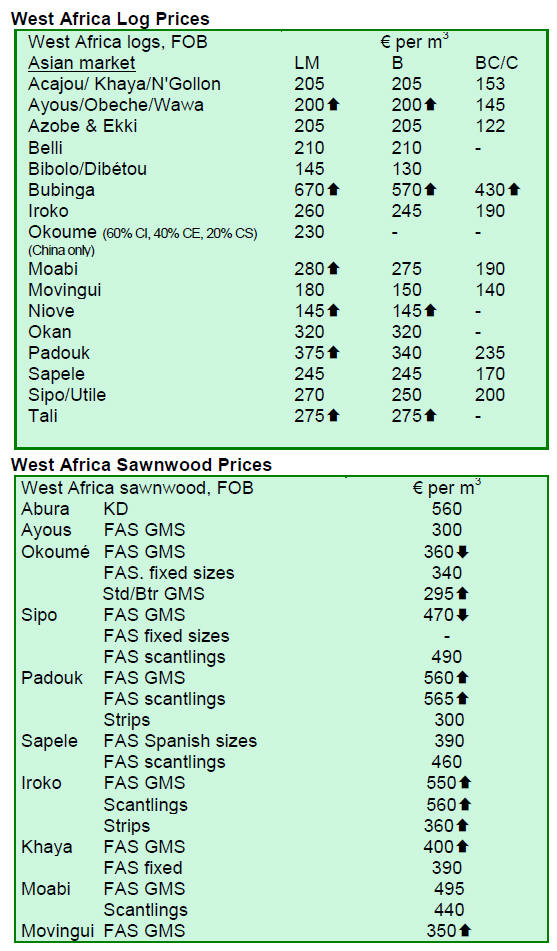
2. GHANA
More export permits for emerging markets
According to the Timber Industry Development Division (TIDD), during the
second quarter of 2010, the head office in Takoradi and its regional office
in Tema issued altogether 15 export permits for the shipment of rosewood
sawnwood (Pterocarpus erinaceus) to China. In terms of volume, the total
amount was 508 cu.m of rosewood sawnwood, worth Euro 166,468 shipped by
Nkoranza Sawmill, Geavag Company Ltd, Effedan Services Ltd, Chester Wood
Supply & Company Ltd and Trust Wood Company Ltd.
In the second quarter of 2010, altogether 57 export permits were issued for
several timber companies to ship teak billets, poles and logs to India,
totaling 4,272 cu.m. In addition, a total of 16 export permits (2,439 cu.m)
were issued in Takoradi for the shipment of Gmelina billets and poles to
India.
One export permit for 151 cu.m of rubberwood sawnwood was issued in Takoradi
for Best Glow Wood Ltd for shipment to Malaysia.
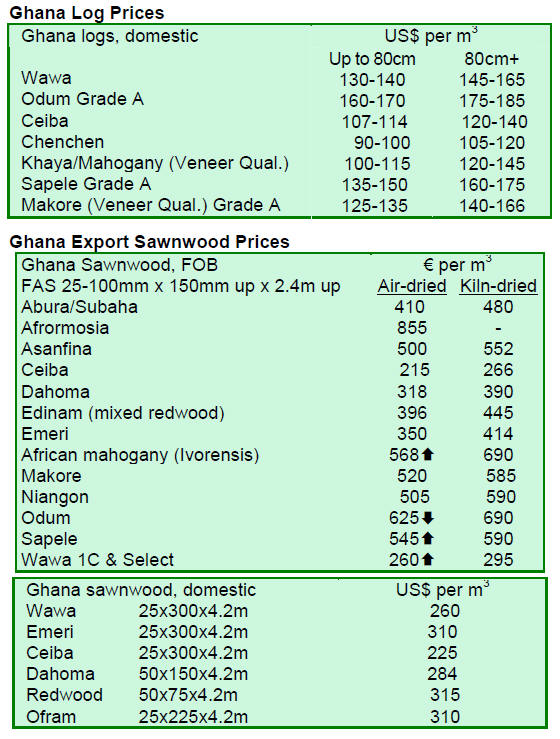
3.
MALAYSIA
Joint effort to promote use of rubberwood
Malaysia and Thailand have agreed to promote jointly the use of rubberwood
by sharing information concerning the regional and international markets for
rubberwood products. A Memorandum of Understanding (MoU) was signed between
the Malaysian Timber Council (MTC), Malaysian Timber Industry Board (MTIB),
Malaysian Furniture Promotion Council (MFPC), Thai Parawood Association and
Wood Processing Industry Club of the Federation of Thai Industries, earlier
this year. Following the signing of the MoU, the Malaysia-Thailand Parawood
Committee (MTPC) was established with the chairmanship and secretariat to be
rotated between the various parties in these countries.
In Malaysia, there are 1.02 million hectares of rubberwood plantations while
in Thailand the rubberwood plantation area is 2.6 million hectares. In 2009,
Malaysia exported wood and timber products worth RM522.8 million to
Thailand, with the major export articles being sawnwood, plywood, wooden
furniture and particleboard.
Rating scheme to improve competitiveness of SMEs
The Malaysian Timber Industry Board (MTIB) in collaboration with the Small
and Medium Sized Enterprises (SMEs) Corporation Malaysia have initiated a
rating scheme to evaluate the performance of SMEs operating in the timber
sector in Malaysia.
The new rating scheme ¡°SME Competitiveness Rating for Enhancement¡± (SCORE)
includes several parameters such as business performance, financial
management, innovation, management and technical capabilities, production
capacity and quality control systems. The purpose of this new rating system
is to enable SMEs to maintain and improve competitiveness in the
international market.
There is an urgent need for the Malaysian timber sector to improve SMEs¡¯
competitiveness as the total export value of wood and timber products fell
14% from RM22.8 billion in 2008 to RM19.5 billion in 2009. The furniture
sector remains the major contributor to total timber product exports with
RM6.28 billion, representing a 32% share of the total export value in 2009.
However, operators in the timber sector are optimistic that the sector will
improve on its 2009 performance. According to the Malaysian Timber Council,
the timber sector is forecast to lift exports by 10% to RM21 billion in
2010. For the first seven months of this year, exports were valued at RM12.3
billion, up 14% over the same period in 2009.
The certification of wood and timber products is expected to improve the
competitiveness of Malaysian timber products and create more international
markets. To date, a total of 160 certificates for chain-of-custody have been
issued under the Malaysian Timber Certification Scheme (MTCS). This is in
addition to the total of 10 forest management units holding valid
certificates under the same scheme covering a total area of 4.83 million
hectares of natural forests.
No time frame for signing of VPA
According to the Ministry of Plantation Industries and Commodities, there is
no time-frame for signing the EU Forest Law Enforcement Governance and Trade
(FLEGT) Voluntary Partnership Agreement (VPA).
However, the EU has indicated that it would like to have the VPA in place
before the EU Illegal Timber Law enters into force in 2013.
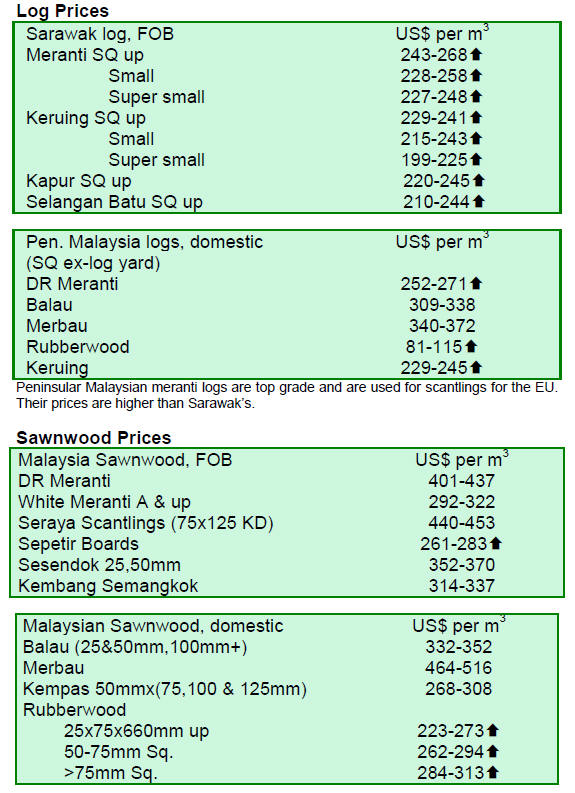
4.
INDONESIA
Arrangement in place for moratorium
Indonesia is set to formally start the implementation of the 2-year
moratorium on new permits to convert natural forests and peatlands next
year, as a presidential decree was expected to be issued before the end of
October 2010. This will pave the way for the country to begin receiving a
grant of US$1 billion from the Norwegian government. The Ministry of
Forestry Indonesia is preparing a new set of regulations to implement the
moratorium.
The moratorium is part of the Indonesian government¡¯s effort to reduce
greenhouse gas emissions by 26% before 2020 as outlined in the National
Action Plan on Climate Change (RAN-GRK). With more support from the
international community, Indonesia hopes to reach a higher emission
reduction target of 41%.
The moratorium will be carried out primarily in Papua, Kalimantan and Aceh
where primary forests and peatlands remain largely unexploited. There are
still around 40 million hectares of natural forests and over 21 million
hectares of peatlands in Indonesia.
Norway is to provide a total of US$200 million for the first phase of the
implementation of the moratorium with the first disbursement of US$30
million to be made in 2010. In 2011 and 2012, US$70 million and US$100
million will be disbursed respectively. The balance of US$800 million will
be disbursed gradually after 2013 based on forestry sector emissions
reduction parameters.
A pilot project will be carried out in one of the proposed areas: Jambi,
Riau, East Kalimantan, Central Kalimantan and Papua. The Office of the
Coordinating Minister of Economic Affairs will select the pilot project area
based on biophysical, social, economic and cultural criteria. The pilot
project will place more emphasis on measuring, verifying and reporting
methodologies.
Indonesia ready for talks on illegal timber with Malaysia
The Ministry of Forestry Indonesia announced that it is preparing to begin
negotiations with Malaysia on allegations that Malaysia has been a
destination point for illegally harvested logs from Indonesia. A Memorandum
of Understanding (MoU) is expected to be signed between Indonesia and
Malaysia to address the issue of timber smuggling.
According to the Ministry of Forestry Indonesia, it has received reports on
smuggled Indonesian timber particularly merbau in the Chinese market,
originating from Malaysia and Singapore. Indonesia and China have already
signed an agreement to eradicate trade in illegally harvested timber and
China is discouraging illegally sourced merbau from entering the Chinese
market.
Aerial seeding for reforestation in South Sulawesi
Officials in South Sulawesi in collaboration with the Kalla Group and the
Hasanuddin University have conducted an experiment of reforestation through
aerial seeding. To date, up to 2 tons of seeds of trambesi and sengon tree
species have been sowed from the air in Moncongloe village in Manuju
district, Gowa region.
The South Sulawesi Forestry Agency noted that it needed a cost-effective
method to reforest a wide land area. The governor of South Sulawesi added
that much money had been spent in the past for reforestation but with poor
results.
The new method of aerial seeding using helicopters is expected to reach
remote areas which could not be reforested using conventional methods. The
plan is to reforest all damaged forest areas in South Sulawesi during the
next 2 years and obtain visible results in 5 years. Twenty helicopters will
be used in this programme to treat up to 100 hectares of damaged forest per
day.
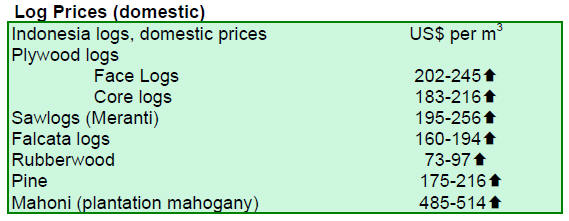
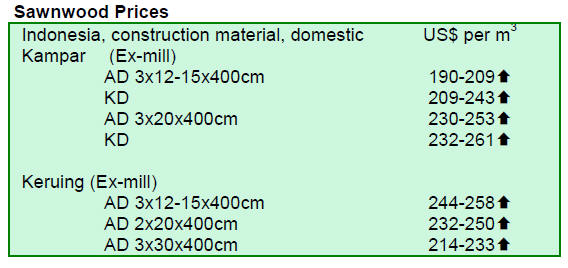
5.
MYANMAR
Slight
improvement in market situation
Both teak and pyinkado markets have marginally improved from the previous
months. However, while traded volumes of pyinkadoe logs are up, the prices
still remain at low levels.
The market for Gurjan logs is subdued and dealers are reportedly having
substantial stocks. The inventories are expected to increase as the dry
season and new harvests begin in November.
Purchases of Myanmar hardwoods by country in October
Purchases of Myanmar hardwoods by country during October 2010 were as
follows: India (3 buyers, 264 Hoppus tons), Thailand (3 buyers, 245 Hoppus
tons) and Hong Kong (1 buyer, 47 Hoppus tons). In the domestic market there
was one buyer, with 59 Hoppus tons in volume.
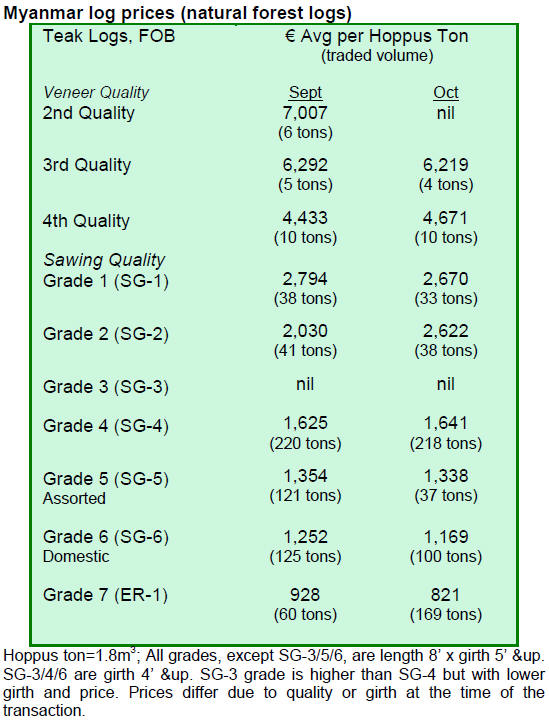
6. INDIA
Industrial output surge
In August 2010, India¡¯s Industrial Output Index jumped 26.5% over the level
recorded in August 2009. For the first five months of fiscal 2010, the
increase in industrial output was 10.6% compared to the same period last
year.
India faces rising housing shortage
According to a World Bank report, India faces a housing shortage of up to 70
million houses. High economic growth, rapid urbanization and rising middle
class have created considerable demand for housing.
The report emphasized the critical role of the private sector in providing
sustainable and affordable housing solutions for lower income groups, as
public sector housing projects alone could not meet the rising demand.
Red sandalwood seized
Nhava Sheva customs recently seized some 20 tonnes of red sandalwood (Pterocarpus
santalinus) which was set to be smuggled out of the country as aluminium
connectors.
The seizure at Nhava Sheva customs was the fifteenth this year for red
sandalwood with false transport documentation. The total seizure during the
current year amounted to 230 metric tonnes of red sandalwood worth Rs.210
million.
Red sandalwood is used in medicines and musical instruments, with Tibet and
Japan being the major markets. Besides Nhava Sheva port, red sandalwood has
been seized at Kandla port and ports on the east coast.
Shipments through land routes have been seized at northern border customs.
According to an expert, large scale commercial plantations may be the
solution to the problem of illegal harvesting of red sandalwood from natural
forests.
Clone technology for increased wood production in teak, eucalyptus and
acacia
Clonal propagation techniques for the mass production of teak, eucalypts and
acacia have been tested by the Kerala Forest Research Institute (KFRI) in
collaboration with several other institutes and industrial establishments.
The techniques involve macro- and micro- propagation of genetically superior
trees.
Forty to fifty years old plus trees of teak (Tectona grandis L. f.), were
cloned using a technique comprising two major steps: production of juvenile
epicormic shoots on branch cuttings obtained from plus trees and rooting
these shoot cuttings. Through this process it takes about 90 days to produce
100 rooted plants from 10-15 branch cuttings. With the introduction of
clonal teak plantations, a 3-4 fold increase in productivity can be
expected.
KFRI has also tested a clonal propagation method for five species of
eucalyptus and four species of acacias. Some of the best eucalyptus clones
have reached a mean annual growth of 71 cu.m per hectare, more than 10 cu.m
per hectare greater than in conventional plantations in Kerala state.
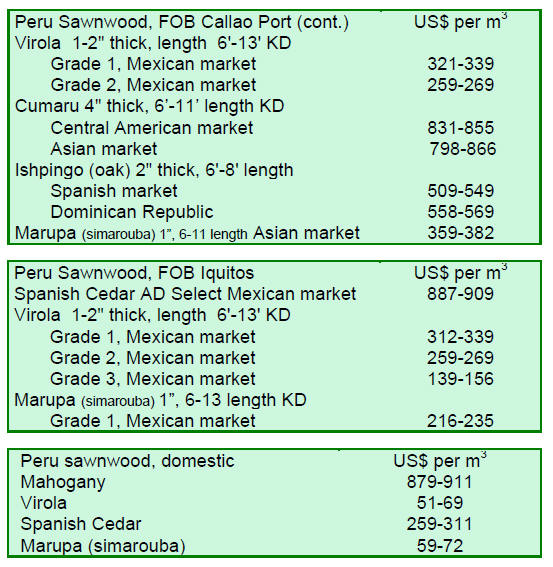
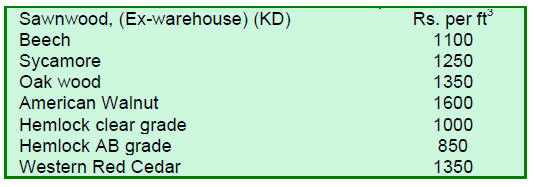
7. BRAZIL
Strong rebound in tropical sawnwood
exports
In September 2010, exports of timber products (excluding pulp and paper)
increased 8.9% to US$206 million from US$190 million in September 2009.
Exports of tropical sawnwood gained in terms of both volume and value, from
46,600 cu.m worth US$21.4 million in September 2009 to 51,300 cu.m valued at
US$23.8 million in September 2010, representing 10.1% increase in volume and
8.7% in value.
In contrast, exports of tropical plywood continued to fall by 22.6% from
6,200 cu.m in September 2009 to 4,800 cu.m in September 2010. In value
terms, the drop was 23.9%, from US$10.9 million to US$8.3 million.
Pine sawnwood exports increased 6.5% in September 2010 compared to September
2009, from US$13.9 million to US$14.8 million. However, in terms of volume,
exports fell 10.5% from 72,300 cu.m to 64,700 cu.m over the period.
The value of pine plywood exports gained 2.9% in September 2010 compared to
the level in September 2009, from US$24.1 million to US$24.8 million.
However, export volumes plunged 20.2% during the period, from 84,600 cu.m to
67,500 cu.m.
For wooden furniture, the value of exports rose 1.9% compared to the level
in September 2009 to US$49.2 million in September 2010.
Mixed performance of wood product exports over the past 12 months
Total exports of timber products including pulp and paper totalled US$6.3
billion, a 19% increase over the past 12 months. However, in August and
September 2010, declines in wood product exports were recorded. Pulp and
paper exports were the main products contributing to improved total timber
exports.
Exports of wooden furniture, softwood and hardwood sawnwood decreased over
the past 12 months. However, exports of these products increased from August
to September 2010 by 2%, 4.6% and 21% respectively.
Softwood and hardwood plywood export volumes declined during the past 12
months, by 23% and 15% respectively.
Argentina emerges as top market for Brazilian furniture
From January to August this year, Brazilian furniture exports grew 14% from
US$441 million during the same period last year to US$502 million.
During the period, Brazilian furniture exports to Argentina jumped 93%
compared to the same period last year, from US$39.6 million to US$76.6
million. As a result, Argentina became the biggest market for Brazilian
furniture exports followed by the US, France and the UK.
Year-to-date furniture exports to the US slipped 7% from US$64.1 million
recorded in the same period last year to US$59.6 million this year.
The increases in furniture exports to Chile and Uruguay were significant
during this period, up 43% and 41% respectively. Furniture exports to these
countries totalled US$41 million in value between January and August 2010,
compared to US$29 million in the same period in 2009.
Timber product prices remain unchanged
The average price of timber products in Brazil remained unchanged from the
previous fortnight. However, prices in US dollars increased 2.9% due to the
strength of the Brazilian currency against the US dollar.
Economy is on track for growth
According to the Brazilian Institute of Geography and Statistics (IBGE), the
Consumer Price Index (IPCA) in September 2010 increased 0.45% over the level
recorded in September last year. The IPCA index for September 2010 was also
well above the August rate of 0.04%. The accumulated IPCA for the first nine
months of the year was 3.6%, a 4.7% increase over the past 12 months.
In September 2010, the average exchange rate to the US dollar was
BRL1.72/US$ compared to BRL 1.82/US$ during the same month of 2009, showing
further strengthening of the Brazilian Real against the US dollar over the
period.
The Copom (Economic Policy Committee) kept the prime interest rate (Selic)
at 10.75% per year in September. This is the second month in a row that the
prime interest rate is kept unchanged.
Illegally harvested timber seized in Sierra Morena
A joint operation by the Brazilian Institute of Environment and Renewable
Natural Resources (IBAMA), the Federal Police and the National Indian
Foundation (FUNAI) resulted in the seizure of about 1,000 cu.m of illegally
harvested roundwood in the indigenous reserve of Sierra Morena.
IBAMA reported that some 50 native Brazilians with bows and arrows blocked
the access of inspectors to the area. According to the Federal Police, 22
trucks, 4 tractors, and 2 vans loaded with logs have been seized in Aripuanã
since the beginning of October.
Wood identification course for Federal Police
The Brazilian Forest Service conducted a wood identification training course
for Federal Police officials. The lack of knowledge on wood identification
hinders enforcement operations as federal police inspectors have not been
able to validate timber loads against the timber transport documentation.
The identification process is important as falsification of documentation of
timber species is common.
The wood identification software used in the course was developed by the
Forest Products Laboratory of the Brazilian Forest Service. It provides 60
different timber characteristics, such as colour, smell, growth rings and
porosity of 158 tree species in the country.
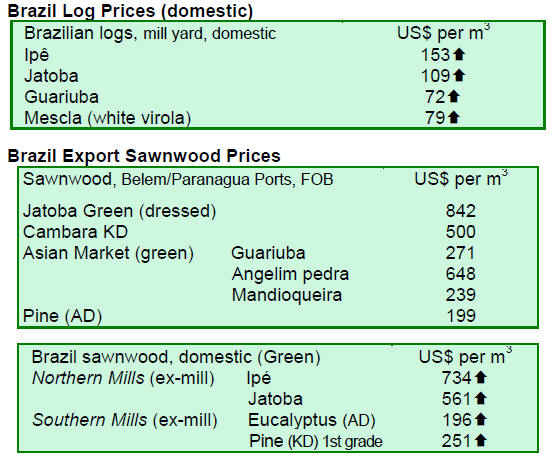
8.
PERU
Wood and timber product exports still below pre-crisis levels
From January to August 2010, exports of wood and timber products totalled
US$114 million, up 30% compared to the same period last year, according to
the Extractive Industries Management Association of Exporters (ADEX).
Despite the significant rise, the result is still lower than the level of
US$155 million recorded in the same period of 2008. In fact, wood and timber
product exports from January to August 2010 were 26% less than the exports
made during the same period in 2008.
During the period, the main timber products exported from Peru were
semi-manufactured products with a 46% share of the total export volume,
worth US$51.9 million.
Sawnwood and veneer/plywood exports amounted to US$39.2 million and US$10.9
million in value respectively.
Exports of furniture and its parts declined slightly by 3% compared to the
same period last year to US$ 4.4 million.
According to ADEX, the top five importers of Peruvian timber products during
the period from January to August 2010 were China, Mexico, US, Dominican
Republic and Italy.
Third FENAFOR fair held in Lima
The 3rd International Fair of Machinery, Equipment and Services for Wood and
Furniture (FENAFOR) was held from 21 to 23 October 2010 at the National
University of Agraria La Molina.
At the fair, some 120 companies producing forestry machineries showcased
their products. In addition, around 30 technical presentations were made by
several national and foreign specialists at the fair. Presentations were
made on low impact harvesting, sustainable forest management, forest
products processing and value-added forest products. The next FENAFOR will
be held in October 2012.
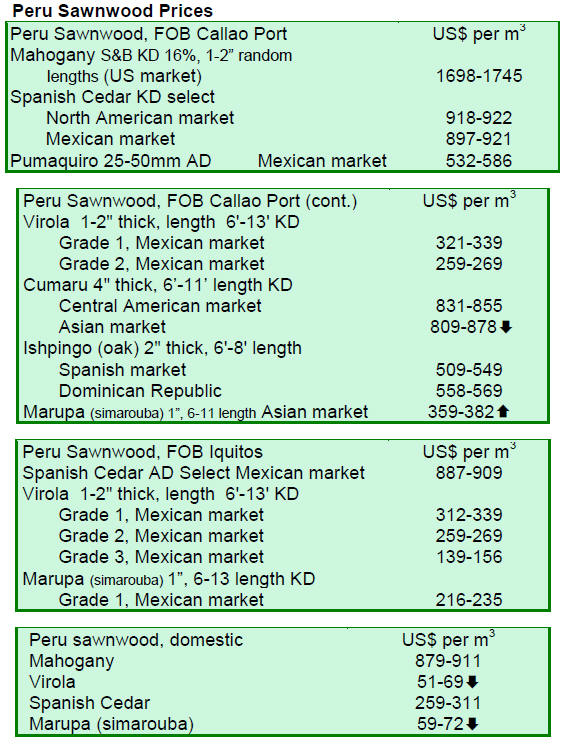
9. GUYANA
Brisk log trade
During the period under review, greenheart and purpleheart logs were on
demand attracting higher average prices for all categories. Mora log prices
retreated for standard and small sawmill quality.
For sawnwood, prices declined in the period under review. Undressed
greenheart (prime) prices remained stable while undressed purpleheart prices
fell. Average prices for undressed mora remained steady. Dressed greenheart
prices slipped while undressed purpleheart prices remained unchanged.
Baromalli plywood attracted a favourable average price for this fortnight
period. Roundwood, fuelwood, poles and piles contributed to the total export
earnings with good average prices and with the US being the major
destination. Splitwood continued to attract buyers in the Caribbean market
at high average price.
For the period under review, exports of value-added products rose. The major
exported products were doors, outdoor garden furniture, windows, spindles
and mouldings made from greenheart, purpleheart, locust (courbaril, jatoba)
and Guyana¡¯s lesser used species darina (angelim). These products were
exported to the Caribbean, European and North American markets.
Affordable core homes for low-income families
The Housing Ministry of Guyana has initiated a project that will provide 113
affordable wooden homes for low income families. The Central Housing and
Planning Authority (CH&PA) of Guyana confirmed that the project will be
implemented in Lusignan and Tabatinga. The project¡¯s financing will be drawn
from the Inter-American Development Bank¡¯s fund for the implementation of
the Second Low Income Settlement Programme, which has a total programme
financing of US$27.9 million.
According to the project plan, the core houses provided are 330 square feet
with timber and concrete structure. A house can be improved and expanded by
its owner up to 743 square feet in total residential area.
Wooden building components used in the houses are affordable and enables the
expansion work and recycling. Wood also adds to better ventilation to
houses.
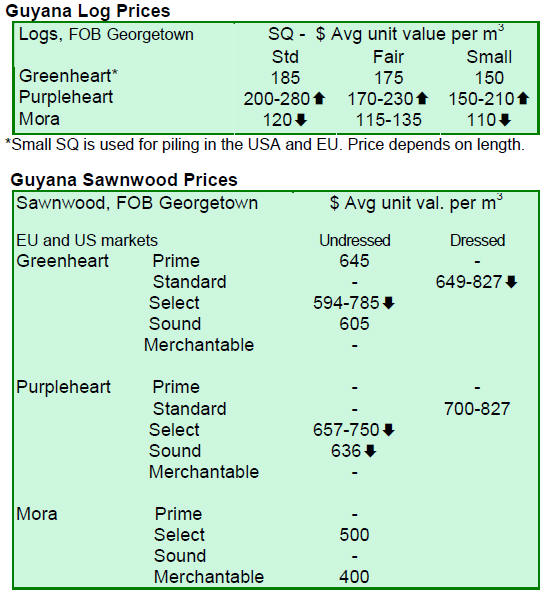
Related News:
|